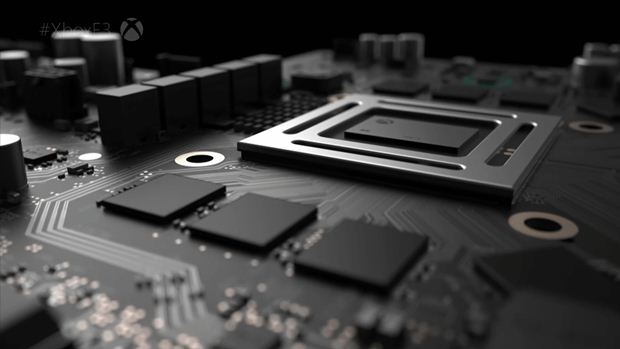
So, it’s Scorpio versus Neo versus…well, whatever it is exactly that Nintendo’s planning to offer (is it a console? A handheld? A flop in the making?)
Post-E3, there’s no need to step lightly around the positively ginormous elephant in the room anymore: The console gaming space has changed in fundamental, perhaps irreversible ways. Let’s leave Nintendo out of the discussion—whatever it is they’re up to with the NX isn’t likely to be about creating a competitive conventional gaming experience. But the Scorpio and PS4 Neo are different beasts entirely. Mid-cycle refresh. That’s the phrase that’s been going around. It best describes what the Neo and Scorpio are: Incremental products that, while offering categorically better performance than their immediate predecessors, are yet still not the kind of radical overhaul that an entirely new console generation entails.
The PS4 and Xbox One, while relatively weak systems for what they were, represented enough of a step over the seventh-gen platforms, that higher end rendering techniques like global illumination, physically-based rendering, and, of course, hi-res textures could be implemented. These were things entirely out of reach of last-gen platforms. On the other hand with the Scorpio and Neo, between the hardware limitation of CPU-bottlenecking, and a product positioning approach that projects the two consoles as “enhanced” versions of the originals, Neo and Scorpio lack the potential for producing categorically new experiences: This is an incremental update—games on Neo and Scorpio will likely run at higher resolutions and higher framerates, (though even that’s somewhat doubtful in every situation if you factor in the CPU deficit), but we may not see Neo-exclusive, or Scorpio-exclusive titles for years, if at all.
This is, of course, is in most part due to a need for retaining existing PS4 and Xbox One owners—the PS4 is Sony’s most successful platform since the PS2, and while the Xbox One hasn’t sold quite as well, 20 million units in three years is no laughing matter. But with all that being said, what are the PS4 Neo and Xbox Scorpio actually capable of? We’ll let the specs speak for themselves:
CPU: Nothing interesting here
The greatest disappointment we have with both the PS4 Neo and the Xbox Scorpio is the marked lack of CPU-side gains to offset the massive gains to GPU power. The PS4 Neo is set to feature an upclocked variant of the Jaguar cores in the PS4, running at 2.1 GHz instead of 1.6 GHz. Microsoft hasn’t yet disclosed the kind of cores the Scorpio will be using, but eight upclocked Jaguar cores is the most likely scenario here: AMD’s Zen architecture is huge—with a 40 percent gain to IPC, it’ll make Team Reds CPU parts performance competitive with Intel for the first time in years. If the Scorpio was going to feature Zen, it would have been a headline feature.
Jaguar wasn’t an architecture AMD built with gaming in mind: the low IPC, low clockspeeds, and conservative power/thermal profiles are much better-suited to bargain basement netbooks and Windows tablets. AI, physics, and streaming, all crucial aspects of world-building—the things that make a game environment a living, breathing space—are heavily dependent on CPU power. As Ubisoft admits, Assassin’s Creed: Unity’s atrocious performance on console could largely be attributed to inadequate CPU power—the consoles couldn’t handle the demands of simulating AI routines for thousands of onscreen NPCs at the same time, so they choked.
While games have certainly gotten prettier since the last generation, limited CPU-side gains have meant that the underlying gameplay hasn’t changed that much—2007’s Assassin’s Creed, with its sprawling, fully-traversable environments and hundreds of onscreen NPCs, was often cited as the first “true” next-gen experience. Bloom effects, dynamic shadows, and ragdoll physics were all possible on PS2 and Xbox hardware if you budgeted carefully, but it was the CPU-side gains with the 360 and PS3 that allowed Assassin’s Creed to have environmental scale like no game before.
With that in mind, we believe that gameplay experiences, unfortunately, will be more of the same with the PS4 Neo and the Xbox Scorpio; lacking the CPU power to flesh out deep, systems-based experiences, we’ll be left with prettier, higher-res versions of today’s games. GPGPU (General-purpose GPU) is a potential curveball here: GPUs are really just highly specialized, massively parallel processors.
GPGPU programming allows for GPUs to handle functions like AI and physics that were traditionally taken care of by the CPU—Nvidia’s PhysX is a particularly well-known example of GPGPU in practice. GPGPU could take the load off the Neo’s and Jaguar’s anaemic CPUs, when it comes to handling detailed physics and AI. But it’s certainly not free: diverting GPU resources to try to overcome CPU limitations can potentially blunt the gains the two have made in graphics power—this will be all the more pronounced with games that run at higher resolutions like 1440p and 4K.
GPU: A question of utilization
What the PS4 Neo and Xbox Scorpio don’t lack is oodles of GPU power. It goes without saying that the Scorpio and Neo are the most powerful consoles ever designed—and much of those gains stem from the all-new Polaris and Vega GPUs inside.
Performance-per-watt is the highlight with Polaris/Vega: The move to the 14nm process means that AMD can extract a lot more performance from smaller, less power-hungry parts. With consoles, TDP-budgeting is crucial: You simply don’t have the luxury of slotting in a 600W power supply to feed a power-hungry GPU. But with parts like the RX 480 offering VR-ready levels of performance within a 150W TDP, Polaris/Vega is a natural choice for the consoles: AMD’s next generation of GPUs offers substantially more performance with lower power requirements that fit right into a console’s tight power budget.
While both the PS4 Neo and the Xbox Scorpio represent a substantial bump over their predecessors in graphics terms, the Scorpio wins out by a significant margin.
The PS4 is set to use a downclocked variant of the Polaris GPU found in the RX 480, with 36 CUs (Compute Units). With the RX 480, AMD is betting big on maximizing the price-performance ratio. At $199, the RX 480 offers unprecedented levels of GPU power in its price bracket. Crossfire is being promoted here as a price-friendly means of getting flagship levels of performance—an RX 480 Crossfire setup actually outguns the GTX 1080. The flip side to this is that the PS4 Neo’s GPU gains aren’t quite as spectacular as what we see with the Scorpio—the Neo offers roughly twice the GPU performance of the PS4—the downclocked Polaris GPU at its heart offers roughly 4.2 Teraflops of compute performance.
In contrast, the Xbox Scorpio is rumoured to use a variant of AMD’s upcoming Vega architecture, with roughly 50 percent more power on offer than the Neo. That 6 Teraflop number being bandied about needs to be taken with a bit of salt, as raw compute performance doesn’t always translate into in-game performance gains: After all, an HD 4870 from circa 2008 manages to hit 1.2 Teraflops, roughly the same as the Xbox One’s Bonaire-derived GPU. However, the R7 260X—the closest PC part to the Xbox One’s GPU, runs circles around the HD 4870, handing in nearly twice the framerate in most games. Nevertheless, the Xbox Scorpio’s GPU is serious business, even if you ignore that 6 Teraflop figure Microsoft’s all too happy to bandy around. The Scorpio’s GPU is likely to be a 56-60 CU part—again downclocked to stick within the power budget.
However, it should be within spitting distance of cards like the GTX 1070. While the PS4 Neo’s GPU upgrade is sufficient to take games from running at 1080p/30 to 1080p/60 (barring CPU bottlenecks), higher resolution gaming, especially at 4K, is out of reach for it. The Neo experience will likely be differentiated by having more advanced effects—higher resolution shadows, global illumination and the like—running on the Neo at 1080p. Microsoft’s been more focused in their approach to the Scorpio’s GPU gains—the Scorpio is apparently meant to offer Xbox One-quality experiences while running at 4K. The move to 4K is massive in terms of image quality (trust us, we game on a 55-inch 4K TV.)
However, it does require literally 4 times the GPU power to drive games at 1080p. 4K/60 FPS gaming is almost certainly out of reach for the Scorpio, barring sidescrollers and indie-titles. However, many AAA games may render natively at 4K, or upscale from a 3K/1440p framebuffer. Of course things can, and do change, and ultimately, it’s up to the developer to decide how to allocate resources—keeping Microsoft’s ambiguous stance on Scorpios in mind, we may even see a couple of near-CGI quality 1080p titles coming out for Scorpio in the years to come. Just looking at the numbers, though, there’s no contest. The Scorpio is far ahead of the PS4 Neo, with as much of a lead over the Neo as the PS4 enjoyed over the Xbox One.
Memory and Memory Bandwidth: About time we got more
Memory bandwidth is another area where the PS4 Neo/Xbox One divide is sharp—the Neo features the same 8GB of GDDR5 as the PS4, though with the memory modules running at 7GHz, offering modest 24 percent bump to memory bandwidth, up to 218 GB/S. The Xbox Scorpio on the other hand is likely to feature 12 GB of GDDR5 with a wider 384-bit bus, offering a staggering 320 GB/S of memory bandwidth. The additional 4GB of memory is significant—the high-res textures that shine at 4K eat up a lot of VRAM. Because the consoles feature a unified memory pool, the GPU will never have access to the full amount of onboard RAM. The PS4 only makes 5 GB of RAM available to developers, reserving the rest for OS functionality.
The GPU will have to share this 5 GB meaning that, in practice, as little as 3.5 GB of VRAM is available to the GPU—with the PS4 Neo also set to feature an 8 GB pool of RAM, this is likely to carry over. This is yet another indication that the Neo isn’t going to run games at 4K—it will not have enough VRAM to load ultra-high res textures. The Xbox Scorpio, on the other hand, is likely to feature 12 GB pool of memory—with an additional 4 GB of memory that’s utilizable by the GPU, the Scorpio has enough space to hit 4K without running out of VRAM.
The higher memory bandwidth is also a telling indicator of Microsoft’s 4K ambitions with the Scorpio: Memory bandwidth scales with resolution. This is why AMD parts like the Fury X, which lag behind their Nvidia counterparts at 1080p, typically close the gap at higher resolutions. The Scorpio’s significant leads in both memory bandwidth and available video memory make it much better suited than the PS4 Neo for handing in native 4K experiences.
Conclusion: To wait or not to wait
When it comes to choosing between the Neo and the Scorpio, timing and availability are just as important. Rumours indicate that the Neo will launch later this year. This is much earlier than the sometime-in-2017 timeframe Microsoft has given us for the Scorpio. While the Scorpio definitely wins out in terms of hardware specs, the PS4 Neo is going to be available, out in the market, for much longer. Your decision is definitely going to be influenced by just how long you’re willing to wait. Another factor here is Microsoft seems to be positioning the Scorpio as an Xbox One that runs games at 4K, sans extra bells and whistles or better performance.
With that in mind, you may not see much of a difference at standard resolutions like 1080p. While 4K is definitely growing as a segment, the vast majority of gamers continue to be at 1080p, and this is where Sony’s PS4 Neo proposition becomes interesting: The Neo appears to be oriented more towards a better 1080p experience, with higher framerates and better special effects, as opposed to a compromised 4K experience.
If Microsoft is serious about the Scorpio just being a “4K Xbox One,” the Scorpio may, ironically offer a worse 1080p experience than the Neo: The Scorpio may output downsampled 4K, which would offer fantastic anti-aliasing, but at 30 FPS, while the Neo will breeze past it, with games running at a native 1080p/60.
You could, alternatively, just sidestep the entire debate and get yourself an RX 480 and a 400W-plus PSU for far less than what either console will likely retail for. Slot those into any existing system you may have and you’ll have the perfect…er…mid-cycle refresh killer!
What do you think about the Neo and Scorpio? Let us know!


















